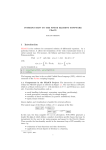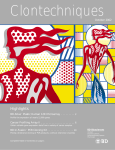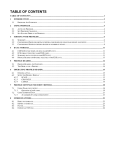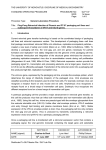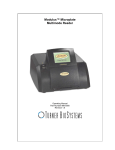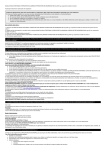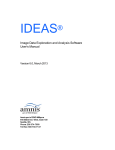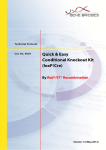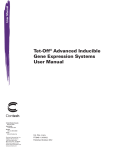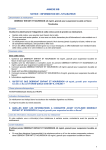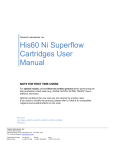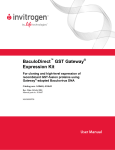Download Creator™ DNA Cloning Kits User Manual
Transcript
Creator™ DNA Cloning Kits User Manual PT3460-1 (PR631583) Published 23 March 2006 Creator™ DNA Cloning Kits User Manual Table of Contents I. Introduction 4 II. List of Components 12 III. Additional Materials Required 13 IV. Creator™ DNA Cloning System 14 A. Before you start 14 B. Creator DNA Cloning Procedure 14 C. Colony pCR 15 V. Typical Results 17 VI. Troubleshooting Guide 18 VII. References 21 VIII. Related Products 22 Appendix A: Creator™ Donor & Control Vector Maps 24 Appendix B: Creator™ Donor Vector MCSs 27 Appendix C: Competent Cells 29 Clontech Laboratories, Inc. www.clontech.com Protocol No. PT3460-1 Version No. PR631583 Creator™ DNA Cloning Kits User Manual Table of Contents continued List of Figures Figure 1. LoxP sequence. 4 Figure 2. Flow chart of the Creator DNA Cloning System. 5 Figure 3. Flow chart of tagging using pDNR-Dual. 8 Figure 4. Typical Plating Result 16 Figure 5. The Creator system easily generates 10 different constructs in one day. 17 Figure 6. Amplification across a recombination juncture. 18 Figure 7. Typical test results for successful recombination. 20 Figure 8. Map of pDNR-1r Donor Vector. 24 Figure 9. Map of pDNR-1r-Luc Control Vector. 24 Figure 10.Map of pDNR-Dual Donor Vector. 25 Figure 11.Map of pDNR-Dual-Luc Control Vector. 25 Figure 12.Map of pDNR-CMV Donor Vector. 26 Figure 13.Map of pDNR-CMV-LacZ Control Vector. 26 Figure 14.MCS of pDNR-1r Donor Vector. 27 Figure 15.MCS of pDNR-Dual Donor Vector. 27 Figure 16.MCS of pDNR-CMV Donor Vector. 28 List of Tables Table I. Creator Acceptor Vectors 9 Table II. Creator Donor Vectors 10 Table III. Recommended Competent Cells 29 Protocol No. PT3460-1 www.clontech.com Clontech Laboratories, Inc. Version No. PR631583 Creator™ DNA Cloning Kits User Manual I. Introduction The Creator™ DNA Cloning Kits provide a revolutionary system for transferring a target gene directly into multiple expression vectors, without the need for time-consuming subcloning steps. With the Creator DNA Cloning Kits, you can study novel protein interactions, tetracycline-regulated expression, signal transduction, retroviral expression, fluorescent protein tagging, and many other applications, simultaneously. Cre-lox site-specific recombination The Creator System uses Cre-loxP site-specific recombination to catalyze the transfer of a target gene from a Donor Vector plasmid containing your gene of interestÑto an Acceptor Vector, a plasmid containing regulatory elements of the desired host expression system (Figure 2). Cre, a 38-kDa recombinase protein from bacteriophage P1, mediates recombination between or within DNA sequences at specific locations called loxP sites (Sauer, 1994; Abremski et al., 1984). These sites consist of two 13-bp inverted repeats separated by an 8-bp spacer region that provides directionality to the recombination reaction (Figure 1). The 8-bp spacer region in the loxP site has a defined orientation which forces your gene to be transferred in a fixed orientation and reading frame. Donor Vectors contain two loxP sites, which flank the 5' end of the MCS and the 5' end of the open reading frame for the chloramphenicol resistance gene (Cmr; Figure 2). Donor Vectors also contain the ampicillin gene for propagation and selection in E. coli, and the sucrase gene from B. subtilis (SacB) for selection of correct recombinants. Acceptor Vectors contain a single loxP site, followed by a bacterial promoter, which drives expression of the chloramphenicol marker after Cre-lox-mediated recombination. The gene of interest, once transferred, will become linked to the specific expression elements for which the Acceptor Vector was designed. Furthermore, if the coding sequence for the gene of interest is in frame with the upstream loxP site in the Donor Vector, it will automatically be in frame with all peptides in the Acceptor Vector. Therefore, you only need to determine the correct reading frame once, and your target gene will always be transferred in the correct reading frame and orientation in the Acceptor Vector after recombination and selection. 8-bp spacer region ATA ACT TCG TAT AGC ATA CAT TAT ACG AAG TTA T Left inverted repeat Right inverted repeat Figure 1. LoxP sequence, showing reading frame. Clontech Laboratories, Inc. www.clontech.com Protocol No. PT3460-1 Version No. PR631583 Creator™ DNA Cloning Kits User Manual I. Introduction continued Donor Vector Insert gene of interest MCS loxP Cmr loxP pDNR-1r Acceptor vectors available for: • • • • • • SacB Ampr Matchmaker two-hybrid analysis High-level constitutive expression Living Colors™ fluorescent protein tagging Tet-regulated inducible expression Retroviral expression Bacterial expression Ampr Gene of interest pDNR-1r loxP Acceptor vector Prok. Promoter Cmr SacB Kanr Promoter/ Peptide Tag loxP pUC ori loxP Cre-lox recombination • Cm/Sucrose selection Promoter/ Peptide Tag Kanr loxP Gene of interest Cmr Desired functional expression vector loxP Prok. Promoter pUC ori Retroviral expression Figure 2. Flow chart of the Creator™ DNA Cloning System showing a representative Donor Vector, pDNR-1r. Protocol No. PT3460-1 www.clontech.com Clontech Laboratories, Inc. Version No. PR631583 Creator™ DNA Cloning Kits User Manual I. Introduction continued Creator™ DNA cloning & expression system Figure 2 provides an overview of the Creator DNA Cloning & Expression System. To transfer your gene from the Donor Vector into any Acceptor Vector, simply incubate the Donor Vector containing your gene of interest and an Acceptor Vector with Cre Recombinase (see Tables I & II for a list of Creator Acceptor and Donor Vectors). Cre binds to the loxP sites on both the Donor Vector and Acceptor Vector, cleaves the DNA, and covalently attaches itself to the DNA. Then Cre catalyzes strand exchange and ligation of the DNA so that the gene is transferred from the Donor Vector into the Acceptor Vector. As a result, a recombinant construct is created that expresses your gene of interest in the desired host system. Chloramphenicol and sucrose selection lets you harvest desired recombinant colonies that contain a directionally correct gene insert. Clones containing the remaining Donor Vector, without your gene insert, will express SacB, and therefore, cannot be grown on media containing sucrose. Transfer target genes easily Traditional cloning practices require several days of tedious restriction enzyme digestion, fragment purification, and re-ligation procedures. The Creator System is so simple that in just one day you can create multiple constructs that are ready for immediate use in functional studies. In separate tubes, combine appropriate Acceptor Vectors with a Donor Vector, containing your gene of interest, and Cre Recombinase. Incubate tube(s) at room temperature for 15 minutes. Next, the enzyme is heat-killed for 5 minutes at 70°C. Transform competent cells with an aliquot of the Creator reaction mixture. After 30–60 minutes in SOC or LB medium, plate cells on agar plates containing chloramphenicol and sucrose for selection of desired recombinants. After colonies are selected, you can immediately prepare DNA for further studies. If desired, recombinant plasmids can be further propagated in either chloramphenicol or the antibiotic that is appropriate for the resistance marker carried by the Acceptor Vector. Creator gives you access to multiple expression systems With Creator you can place your gene within multiple systems for functional analysis. Clontech offers Acceptor Vectors for many of our most powerful systems (Table I). The Matchmaker™ Acceptor Vectors enable you to discover novel protein-protein interactions using the Matchmaker Two-Hybrid System 3. The Living Colors™ Acceptor Vectors allow you to generate C-terminal fusions of your target gene to a fluorescent tag for protein localization studies. For dosedependent inducible expression studies of your protein, transfer your gene into an Acceptor Vector that is compatible with both Tet and the retroviral RevTet™ Gene Expression Systems. The IRES bicistronic expression Acceptor Vectors have an IRES (internal ribosomal entry site) sequence and a constitutive CMV promoter to produce a bicistronic message for high expression of your protein Clontech Laboratories, Inc. www.clontech.com Protocol No. PT3460-1 Version No. PR631583 Creator™ DNA Cloning Kits User Manual I. Introduction continued in mammalian cells. The pLP-PROTet-6xHN Acceptor Vector (Cat. No. 631201) yields high inducible protein levels in bacterial cells for easy purification with TALON® resin. For more information on these and other Creator vectors, please refer to Tables I and II or visit the Clontech page at www.clontech.com. Complete Systems compatible with Creator are available for several of our gene expression systems. These complete kits offer a streamlined approach to expressing your target gene. See Section VIII, Related Products for a current list. Creator Cloning Kits The Creator™ pDNR Cloning Kit (Cat. No. 631615) is a reformulated version of our original Creator Cloning Kit. The Donor Vector in this kit, pDNR-1r is designed to increase recovery of recombinant vectors containing insert. The pDNR Cloning Kit can be used to transfer a target gene into any of our wide range of expression Acceptor Vector in the presence of Cre recombinase. Donor Reporter Vectors generate reporter constructs in 15 minutes Our Donor Reporter Vectors, pDNR-SEAP, and pDNR-LacZ allow you to rapidly generate reporter constructs for any gene expression system. Using the standard 15 minute recombination reaction, Cre recombinase mediates the transfer of the reporter from the Donor Vector to any expression Acceptor Vector. The resulting reporter Acceptor Vectors are suitable for many uses, including transfection efficiency controls or quantifiers of induction of gene expression. These reporters are also ideal for normalizing your data. Ready-made Creator™ LibrariesÑor generate your own The Creator ™ SMART™ cDNA Libraries were developed to serve as the foundation for the Mammalian Gene Collection (MGC) project, a joint effort of the National Institutes of Health (NIH) and the National Cancer Institute (NCI). This project aims to facilitate the search for and isolation of your target gene by providing researchers with a full set of inexpensive, full-length clones and sequences from human and other mammalian sources. Using a full-length sequencing pipeline, the project produces 5,000 highly accurate full-length sequences per year. These sequences are analyzed by a bioinformatics group, and then made available to the research community through GenBank and the MGC website (http://mgc. nci.nih.gov). By providing the biomedical research community with inexpensive, full-length clones in a rapid-cloning format, the MGC project hopes to accelerate the functional analysis of genes identified by mammalian genome projects. Currently, nearly 1,000 full-length, sequenced-verified cDNAs that are cloned into the pDNR-LIB Vector from the Creator SMART cDNA Libraries are available through the I.M.A.G.E. Consortium. The libraries can be quickly screened, and your full-length cDNA clones isolated by standard procedures. The target gene is then efficiently transferred into a variety of expression vectors for functional analysis. The Creator Libraries are available from numerous cancer and normal tissues from various sources. Protocol No. PT3460-1 www.clontech.com Version No. PR631583 Clontech Laboratories, Inc. Creator™ DNA Cloning Kits User Manual I. Introduction continued Promoter loxP 5' Tag Gene of interest pDNR-Dual Donor Vector Desired Acceptor Vector Prok. Promoter Cmr SacB loxP SD SA 3' Tag loxP Promoter 5' Tag loxP Gene of interest Expresssion Clone SD 3' Tag r Cm loxP SA Prok. Promoter mRNA (before splicing) SA SD 5' Tag 3' Tag Start Stop loxP mRNA (after splicing) Gene of interest Cmr loxP Prok. Promoter 5' Tag 3' Tag Start Stop loxP Gene of interest Figure 3. Flowchart of tagging using pDNR-Dual. The pDNR-Dual Donor Vector contains a splice donor (SD) site directly downstream of the Multiple Cloning Site (MCS). The SD site, which is transferred from pDNR-Dual along with the gene of interest, mediates the fusion of the gene to the tag in the Acceptor Vector through intron splicing. As a result, a transcript is created that expresses the tag as a 3' fusion to your gene of interest in a eukaryotic host system. Clontech Laboratories, Inc. www.clontech.com Protocol No. PT3460-1 Version No. PR631583 Creator™ DNA Cloning Kits User Manual I. Introduction continued Table I. Creator™ Acceptor Vectors Acceptor Vector pLP-GADT7 pLP-GBKT7 pLP-AcGFP1-C pLP-IRESneo pLP-TRE2 pLP-RevTRE pLP-LNCX pLP-CMVneo pLP-CMV-Myc pLP-CMV-HA pLP-PROTet -6xHN pLP-BacPAK9 Promoter/Features ADH1/GAL4 activation domain ADH1/GAL4 DNA-binding domain CMV/ fusions of gene to C-terminal of AcGFP CMV/IRES, neo selection marker Inducible tet-responsive expression vector Inducible tet-responsive promoter in retroviral expression vector with hyg selection CMV promoter in retroviral expression vector with neo selection CMV promoter with neo selection CMV/C-terminal fusions to Myc CMV/C-terminal fusions to HA Inducible tet-responsive expression vector Prokaryotic promoter baculoviral construct Functional Application Express fusions to GAL4 AD to study protein interactions through two-hybrid screening. Express fusions to GAL4 DNA-binding domain to study protein interactions through two-hybrid screening. Express fusions to AcGFP (Aequora coerulescens green fluorescent protein) to study localization of the protein of interest in live cells; no dyes or cofac- tors required. Constitutive mammalian expression with single transcript for both gene of interest and neo selection marker. High-level, regulated promoter for expression in mammalian cells. High-level, regulated retroviral expression in mammalian cells. Constitutive retroviral expression. Constitutive mammalian expression Express fusions to Myc tag for detection Express fusions to HA tag for detection High-level, regulated promoter for expression in bacteria through two-hybrid screening. Constitutive baculoviral expression * Only compatible with genes cloned in pDNR-Dual Donor Vector. Protocol No. PT3460-1 www.clontech.com Version No. PR631583 Clontech Laboratories, Inc. Creator™ DNA Cloning Kits User Manual I. Introduction continued Table II. Creatorª DONOR Vectors Donor Vector pDNR-1r pDNR-Dual pDNR-CMV pDNR-LIB pDNR- LacZ pDNR- SEAP Promoter/Features T7 promoter, M13 F/R primer sites, SacB selection T7 promoter, M13 forward site, SD site, 6xHN c-ter tag, SacB selection CMV promoter, M13 F/R primer sites, T7 promoter, SacB selection T7 promoter, M13 F/R primer sites, SacB selection SacB selection Functional Application T7 RNA polymerase primer/promoter site upstream of MCS for in vitro tran- scription/translation of gene of interest T7 RNA polymerase primer/promoter site upstream of MCS for in vitro transcription/translation of gene of interest C-ter tagging by intron splicing in Eukaryotes and has built in 6xHN tag at C-ter for bacteria. T7 RNA polymerase primer/promoter site upstream of MCS for in vitro tran- scription/translation of gene of interest, CMV promoter for expression testing in mammalian cells prior to transfer smaller pDNR 1 vector, T7 RNA poly- merase primer/promoter site upstream of MCS for in vitro transcription/transla tion of gene of interest, designed for library construction using SMART™ Library Construction Kit Donor Vector with Reporter genes for enzymatic quantitation or cell staining assay The Creator™ SMART™ cDNA Library Construction Kit (Cat. No. 634903) provides a dependable method for producing high-quality, cDNA libraries compatible with Creator Systems specific for your research needs. SMART technology makes it possible to generate full-length, directionally cloned cDNA Libraries from nanograms of total or poly A+ RNA. Using the Creator Cloning System, isolated clones from finished libraries can be transferred directly to expression Acceptor Vectors for functional analysisÑwithout the need for subcloning. Advantages over other Cre-lox systems In the Creator System, two loxP sites in the Donor Vector flank the MCS and chloramphenicol open reading frame, so only this small region of the Donor Vector is transferred to the Acceptor Vector. In other systems, there is only one loxP site in the Donor Vector causing both the donor and Acceptor Vectors to fuse into one large plasmid. Thus, single loxP site-based Donor Vectors are not compatible with retroviral and IRES Acceptor Vectors due to size constraints. The small expression vector produced by the Creator System is easier to use and is ideal for a variety of downstream applications, including retroviral expression. Creator does not require PCR cloning methods so there is no need to sequence the entire gene insert. Your sequence remains intact, an especially important Clontech Laboratories, Inc. www.clontech.com 10 Protocol No. PT3460-1 Version No. PR631583 Creator™ DNA Cloning Kits User Manual I. Introduction continued feature for genes undergoing functional studies. Other systems require you to sequence the full insert because their procedures use PCR-based cloning, which may introduce errors due to the low fidelity of some thermostable polymerases. Another advantage of the Creator System is that you can transform any standard competent cell lines, such as DH5α cells, after performing Cre-mediated recombination. In addition, Cre Recombinase is the only enzyme necessary for the recombination reaction, and it does not require additional cofactors, nor does it have a preference for linear over supercoiled DNA. The Creator DNA Cloning Kits include Cre Recombinase, a Donor Vector, a Control Donor Vector, 10X BSA, and 10X Cre Reaction Buffer. Each kit includes sufficient reagents to perform 10 reactions. In addition, Cre Recombinase can also be purchased separately (Cat. No. 631614; sufficient for 20 reactions). Clontech offers a variety of competent cells and a wide range of Acceptor Vectors. Protocol No. PT3460-1 www.clontech.com Version No. PR631583 Clontech Laboratories, Inc. 11 Creator™ DNA Cloning Kits User Manual II. List of Components Store vectors at –20°C. Store all other components at –70°C. After the first use, store Cre Recombinase at –20°C in a non-frost-free freezer. Creator DNA Cloning Kits each include sufficient reagents to perform 10 reactions as described in this User Manual. Creator pDNR Cloning Kit (Cat. No. 631615) • 20 µg • 20 µg • 10 µl • 100 µl • 100 µl • pDNR-1r Vector (500 ng/µl) pDNR-1r-Luc Control Vector (500 ng/µl) Cre Recombinase 10X Cre Reaction Buffer 10X BSA (1 mg/ml) pDNR-1r Vector Information Packet (PT3616-5) Cre Recombinase (Cat. No. 631614) • 20 µl Cre Recombinase • 100 µl 10X Cre Reaction Buffer • 100 µl 10X BSA (1 mg/ml) Clontech Laboratories, Inc. www.clontech.com 12 Protocol No. PT3460-1 Version No. PR631583 Creator™ DNA Cloning Kits User Manual III. Additional Materials Required The following materials are required but not supplied: • Acceptor Vectors (For ordering information, see Related Products.) •Electrocompetent or chemically-competent cells See Table III. (For ordering information, see Related Products.) Note: "One shot" TOP10 cells are not compatible with the Creator Cloning System. • Chloramphenicol stock solution (Cm) (30 mg/ml in 100% ethanol; 1000X.) Store at –20°C. • Ampicillin stock solution (Amp) (100 mg/ml in H2O; 1000X.) Store at –20°C. • SOC Medium 20 g/L Bacto-tryptone 5 g/L Bacto-yeast extract 0.5 g/L NaCl Add 10 ml of a 250 mM solution of KCl, and adjust the pH to 7.0. Autoclave. Prior to use, add 5 ml of 2 M MgCl2 (autoclaved). • LB broth 10 g/L Bacto-tryptone 5 g/L Bacto-yeast extract 5 g/L NaCl Adjust pH to 7.0 with 5 N NaOH. Autoclave. • LB/amp agar plates Prepare LB as described above. Prior to autoclaving, add agar (15 g/L). After autoclaving, cool to 55°C and add ampicillin (100 µg/ml; final concentration). Pour into 10-cm plates and let harden. Then invert plates and store at 4°C. • LB/Cm/sucrose agar plates Prepare LB as described above. Prior to adjusting pH, add sucrose (7% w/v). Add agar (15 g/L) and autoclave for 20 minutes maximum (longer autoclaving times may cause sucrose to burn). After autoclaving, cool to 55°C and add chloramphenicol (30 µg/ml). Pour into 10-cm plates, and let harden. Then invert plates and store at 4°C. Protocol No. PT3460-1 www.clontech.com Version No. PR631583 Clontech Laboratories, Inc. 13 Creator™ DNA Cloning Kits User Manual IV. Creator™ DNA Cloning Protocol A. Before you start • Although the reading frame of the insertion is only significant when transferring into Acceptor Vectors that express fusion proteins, we strongly encourage you to clone your gene of interest in frame with the Donor Vector's upstream loxP site to ensure compatibility with all of our Acceptor Vectors. For detailed Donor Vector maps and multiple cloning site diagrams, see Appendices A & B. • When using the pDNR-Dual Cloning Kit for the addition of 3' tags to a gene of interest, the sequence cloned into pDNR-Dual must be in frame with the SD site, and lack stop codons and a 3' UTR for correct expression of the protein-tag fusion. • Cre recombinase requires heat to efficiently inactivate the enzyme following the reaction. The enzyme retains activity even when reactions are stored at 4°C. • Sucrose and chloramphenicol selection is only required for initial selection of correct recombinants. After selection, recombinant clones can be grown in the same medium used for propagation of the Acceptor Vector. • For best recombination efficiency, we recommend using NucleoSpin® Plasmid Miniprep or Maxiprep Kits to obtain highly pure plasmid DNA (see Related Products for ordering information). • Verify plasmid concentration by gel electrophoresis before performing the recombination reaction. Please note that spectrophotometer readings can be inaccurate in particular when RNA is column purified. • Please see Appendix C for a list of recommended competent cells. • We strongly recommend that you perform a control reaction using the Control Donor Vector provided in each kit. Performing a control reaction will verify that your system is working properly. B. Creator™ DNA Cloning Procedure 1.Subclone your gene of interest into the Donor Vector using standard methods. (For more information, consult Sambrook et al., 2001.) 2.Prepare the Creator reaction mixture as follows: 200 ng Donor Vector 200 ng Acceptor Vector 2 µl 10X Cre Reaction Buffer 2 µl 10X BSA (1 mg/ml) 1 µl Cre Recombinase Add deionized H2O to bring volume up to 20 µl. Notes: • We recommend performing a parallel control reaction with the appropriate Control Vector as described above (Section A). Clontech Laboratories, Inc. www.clontech.com 14 Protocol No. PT3460-1 Version No. PR631583 Creator™ DNA Cloning Kits User Manual IV. Creator™ DNA Cloning Protocol continued • The first time you use Cre Recombinase, thaw rapidly from –70°C by holding the tube between your fingers until almost all of the ice is melted. Then place the tube on ice. • Once thawed, the Cre Recombinase should be stored at –20°C in a non-frost-free freezer. The Cre solution will remain a liquid and will not need to be thawed prior to use. 3.Mix well by gently tapping the tube. Spin briefly. 4.Incubate at room temperature (22–25°C) for 15 min. Note: Do not extend incubation past 15 min; competing recombination reactions, which do not generate desired recombinants, can reduce the yield of your desired recombinants. 5.Stop the reaction by heating tube at 70°C for 5 min. 6.Transform competent cells with 1 µl of reaction mixture. Use at least 50 µl of competent cells per 1 µl of reaction mixture. See Appendix C for a list of recommended competent cells and volumes to use. Note: Competent cells should give >1 x 108 cfu/µg. If not, replace with a fresh sample of cells. 7.Grow cells at 37°C for 60 min in SOC medium (or LB). 8.Plate 100 µl of transformation on a 10-cm LB-agar plate containing 30 µg/ml chloramphenicol, and 7% sucrose (w/v). 9.Centrifuge at 6,000 rpm for 1 min. 10.Aspirate off 800 µl. 11.Resuspend in 100 µl of SOC medium (or LB) and plate on a 10-cm LB agar plate containing 30 µg/ml chloramphenicol, and 7% sucrose (w/v). Incubate overnight. Note: It is important to allow the innoculum to soak into the plate thoroughly before incubating overnight. 12.The next day, the plate should contain a mixture of larger colonies and smaller colonies. Pick larger colonies for screening by colony PCR (Figure 4). Smaller colonies typically contain a mixture of Donor and Acceptor Vector DNA. Analyze clones by restriction digest to confirm your final construct. Plasmid(s) can be further propagated in either chloramphenicol or the antibiotic that is appropriate for the resistance marker of the Acceptor Vector. C. Colony PCR 1.Create a 0.4 µM primer master mix. 50 µl of this mix will be required per colony screened. For recombinations involving the acceptor vectors pLP-CMV-HA or pLP-CMV-Myc, use a combination of primers PCP1 and PCP-L. For all other acceptor vectors use PCP-1 and PCP-2. Primer sequences are: PCP-1: GCTCACCGTCTTTCATTGCC PCP-2: TCCGCTCATGAGACAATAACC PCP-L: TGTATCTTATCATGTCTGGATC Protocol No. PT3460-1 www.clontech.com Version No. PR631583 Clontech Laboratories, Inc. 15 Creator™ DNA Cloning Kits User Manual IV. Creator™ DNA Cloning Protocol continued Figure 4. Typical plating result. Arrows indicate examples of larger colonies that are good choices for selection and screening by colony PCR. 2.Aliquot 50 µl of primer master mix to wells of a microtiter plate or strip. Pick large colonies from the plate in step 12 and pipet up and down several times to resuspend the bacteria. Use 25 µl of this master mix of bacteria and primers to resuspend the contents of one well of a Sprint Advantage 96 plate (Cat. No. 639550). Alternatively, other methods for "colony PCR" may be employed. It is important however, to add broth (eg. LB or SOC) containing 30 µg/ml Chloramphenicol or another antibiotic that is appropriate for your plasmid to the resuspended colony within ten minutes. This will ensure the viability of antibiotic-resistant bacteria. 3.Perform the PCR and analyze as described in the troubleshooting guide (No or few colonies > Recombination reaction failed: Steps 3–5). Clontech Laboratories, Inc. www.clontech.com 16 Protocol No. PT3460-1 Version No. PR631583 Creator™ DNA Cloning Kits User Manual V. Typical Results Figure 5 shows typical results using the Creator DNA Cloning System to generate multiple constructs, each containing a target gene. In separate tubes, pDNR-Luc Control Vector was combined with Cre Recombinase and ten different Acceptor Vectors. After a brief recombination, DH5α competent cells were transformed with an aliquot of reaction mixture and recombinants were selected. With only three colonies selected from each transformation, we obtained the desired recombinants containing luciferase from all 10 reactions. Out of 30 colonies picked in total, all but two contained the proper insert. With the Creator DNA Cloning Kits, 95–100% of analyzed clones will contain your desired recombinant construct. pLP-TRE2 A M 1 2 pLP-RevTRE 3 P 1 2 3 pLP-LNCX P B pLP-ECFP-C1* C M 1 2 3 M 1 2 3 1 pLP-EGFP-C1* P 1 pLP-GADT7 D M 2 2 1 2 3 3 P 1 2 3 P pLP-EYFP-C1* 1 pLP-GBKT7 P 3 pLP-IRES2-EGFP* 2 3 pLP-IRESneo P 1 2 3 P Figure 5. The Creator™ system easily generates many constructs in one day. Luciferase was transferred into each of ten Acceptor Vectors. Three clones for each construct were then screened by restriction digest to confirm transfer of the luciferase gene. All but two of the 30 colonies contained the correct recombinant construct. P = parental vector. M = marker. *Discontinued products as of 3/3/2005. Data shown was obtained prior to 3/3/2005, pLP-AcGFP1-C is now available as a replacement for pLP-EGFP-C1, pLP-ECFP-C1, and pLP-EYFP-C1. Protocol No. PT3460-1 www.clontech.com Clontech Laboratories, Inc. Version No. PR631583 17 Creator™ DNA Cloning Kits User Manual VI. Troubleshooting Guide The simplicity of the Creator DNA Cloning System makes its use fairly straightforward. If you do not achieve typical results, this guide may help you to determine the source of the problem. No or few colonies Colonies of varying size • Sometimes distinct large and small colonies may be seen. In such cases, we generally find it best to pick the larger colonies. Small colonies tend to be mixtures of recombinant plasmid and Acceptor Vector. Low transformation efficiency • Check transformation efficiency. You should obtain >1 x 108 cfu/µg; otherwise use new, fresh competent cells. Too much Cre used in the reaction • To ensure that an accurate volume of Cre recombinase is added to the reaction mix, use a 2- or 10-µl pipettor. Cell type used • While in general there is no specific requirement to use a given E. coli strain, there is some variability in overall efficiencies in different cell types. Thus, if you have low colony numbers or get colonies that are mixtures (see above), then trying a different cell type can help. Test both electro- and chemically competent versions of different cell types (e.g., DH10B, XL1-Blue, Fusion-Blue, or DH5α) for best results. Incubation of reaction exceeded 15 minutes • Do not incubate Creator Reaction Mixture longer than 15 minutes. Competing recombination events can reduce the yield of your desired recombinants. • Ensure that Cre recombinase is heat-killed immediately following incubation. We have found that the reaction is relatively temperature insensitive, and can even occur on ice. For this reason, it is critical that you closely monitor the reaction time and proceed to the next step in the protocol immediately, rather than let the reaction sit on ice. Poor plasmid DNA quality PCP-1 PCP-2 r Cm loxP Prok. Promoter Promoter loxP Gene of interest Figure 6. Amplification across a recombination juncture. The two primers, PCP-1 and PCP-2, prime from the chloramphenicol marker and prokaryotic promoter, respectively. Since these two elements are only linked through recombination, successful PCR amplification indicates a successful recombination reaction. Clontech Laboratories, Inc. www.clontech.com 18 Protocol No. PT3460-1 Version No. PR631583 Creator™ DNA Cloning Kits User Manual VI. Troubleshooting Guide continued • For best results, we recommend using NucleoSpin Plasmid Products to obtain highly pure, miniprep plasmid DNA. For ordering information, see Related Products, Section VIII. • To accurately determine plasmid DNA concentration, analyze an aliquot of your miniprep, alongside a Molecular weight standard, on a 0.8–1.0% agarose/EtBr gel. Photograph the gel and compare the band intensity of the plasmid to the band intensities of the mass standards to quantify. Please note that spectrophotometer readings can be inaccurate in particular when DNA is column-purified. Recombination reaction failed 1.To test the success of the recombination reaction, set up a PCR reaction mixture using TITANIUM™ Taq (Cat. No. 639208) and primers (PCP-1 and PCP-2) that amplify across a recombination juncture (see Figures 2 and 6). Please note: Use Primer PCP-L instead of PCP-2 if using pLP-CMV-Myc or pLP-CMV-HA as Acceptor Vectors. 2.Set up the PCR reaction in a PCR tube as follows: Test Negative Sample Control 18.5 µl 19.5 µl PCR-Grade Water 2.5 µl 2.5 µl 10X TITANIUM Taq PCR Buffer 1 µl Creator Reaction Mixture 1 µl 1 µl PCP-1 Primer (10 µM) 1 µl 1 µl PCP-2 Primer (10 µM) 0.5 µl 0.5 µl 50X dNTP Mix (10 mM ea. of dATP, dCTP, dGTP, dTTP) 0.5 µl 0.5 µl 50X TITANIUM Taq DNA Polymerase 25 µl 25 µl Total volume Primer PCP-1: 5'-GCTCACCGTCTTTCATTGCC-3' Primer PCP-2: 5'-TCCGCTCATGAGACAATAACC-3' Primer PCP-L: 5'-TGTATCTTATCATGTCTGGATC-3' 3.Commence thermal cycling using the following parameters. These are general guidelines for use with hot-lid thermal cyclers; the optimal parameters may vary with different thermal cyclers. •94°C for 2 min •25 cycles: 94°C 15 sec 58°C 30 sec 72°C 30 sec •72°C for 5 min Protocol No. PT3460-1 www.clontech.com Version No. PR631583 Clontech Laboratories, Inc. 19 Creator™ DNA Cloning Kits User Manual VI. Troubleshooting Guide continued 4.Transfer a 5-µl sample of your PCR reaction to a fresh tube and add 1 µl of 5X stop/loading buffer. Analyze your sample(s) by electrophoresis on a 2.0% agarose/ethidium bromide gel, along with suitable DNA size markers. 5.Expected results: The reaction should produce a major fragment of 356 bp. No bands should be generated in the negative (i.e., no DNA template) control. Note: This test is also a very simple way to screen colonies for recombinants. M – + kb 3 2 1.5 1 0.5 ← Figure 7. Typical test results for successful recombination. Clontech Laboratories, Inc. www.clontech.com 20 Protocol No. PT3460-1 Version No. PR631583 Creator™ DNA Cloning Kits User Manual VII. References Abremski, K. & Hoess, R. (1984) Bacteriophage P1 site-specific recombination. Purification and properties of the Cre recombinase. J. Biol. Chem. 259:1509–1514. Creator DNA Cloning & Expression System (April 2000) Clontechniques XI(2):7–11. Sambrook, J., Fritsch, E. F. & Maniatis, T. (2001). Molecular Cloning: A Laboratory Manual, Cold Spring Harbor Laboratory Press (Cold Spring Harbor, NY). Sauer, B. (1994) Site-specific recombination: developments and applications. Curr. Opin. Biotechnol. 5:521–527. For additional reading Barabino S. M. L. & Keller, W. (1999) Last but not least: regulated Poly(A) Tail Formation. Cell 99:9–11. Guo, F., Gopaul, D. N. & Van Duyne, G. D. (1997) Structure of Cre recombinase complexed with DNA in a site-specific recombination synapse. Nature 389:40–46. Lilley, D. M. J. (1997) Site-specific recombination caught in the act. Chem. Biol. 4:717–720. Protocol No. PT3460-1 www.clontech.com Clontech Laboratories, Inc. Version No. PR63158321 Creator™ DNA Cloning Kits User Manual VIII.Related Products For the latest and most complete listing of all Clontech products, please visit www.clontech.com Products Cat. No. • Creator™ pDNR Cloning Kit 631615 • Creator™ SMART™ Premade cDNA Libraries many • Creator™ SMART™ cDNA Library Construction Kit 634903 • Creator™ Acceptor Vector Construction Kit 631618 Donor Reporter Vectors • pDNR-LacZ Donor Reporter Vector 631612 • pDNR-SEAP Donor Reporter Vector 631613 Living Colors® Expression Vectors • pLP-AcGFP1-C Acceptor Vector 632471 • pLPS-AcGFP1-N Acceptor Vector* 632472 Mammalian Expression Vectors • pLP-IRESneo Acceptor Vector 631607 • pLP-CMV-Myc Acceptor Vector 631603 • pLP-CMVneo Acceptor Vector 631816 • pLP-CMV-HA Acceptor Vector 631817 Matchmaker Vectors • pLP-GADT7 Acceptor Vector 630405 • pLP-GBKT7 Acceptor Vector 630406 Retroviral Expression Vectors • pLP-LNCX Acceptor Vector 631504 • Adeno-X™ Expression System 631524 * Only compatible with genes cloned in pDNR-Dual Donor Vector. Clontech Laboratories, Inc. www.clontech.com 22 Protocol No. PT3460-1 Version No. PR631583 Creator™ DNA Cloning Kits User Manual VIII.Related Products continued Inducible Mammalian Expression Vectors & Systems • pLP-RevTRE Acceptor Vector 631015 • pLP-TRE2 Acceptor Vector 631016 • RevTet-Off Retroviral Gene Expression System featuring Creator cloning 631023 • RevTet-On Retroviral Gene Expression System featuring Creator cloning 631024 Bacterial Expression Vectors & Systems • pLP-PROTet-6xHN Acceptor Vector 631201 • Creator-Compatible PROTet-6xHN Bacterial Gene Expression System 631204 Baculovirus Expression Vectors & Systems • BacPAK™ Baculovirus Expression System 631402 • pLP-BacPAK9 Acceptor Vector 631407 • pLP-BacPAK9-6xHN Acceptor Vector 631408 • BacPAK6 DNA (Bsu36 I digest) 631401 Competent Cells • Fusion-Blue™ Competent Cells 636700 • Supercharge EZ10 Electrocompetent Cells 636756 Plasmid Purification Kits • NucleoSpin® Plasmid Miniprep Kits 636042 635988 • NucleoSpin® Multi-8 Plasmid Kits 635973 635974 • NucleoSpin® Multi-8 Plus Plasmid Kits 635975 635976 • NucleoSpin® Multi-96 Plasmid Kit 636007 636005 636006 Protocol No. PT3460-1 www.clontech.com Clontech Laboratories, Inc. Version No. PR63158323 Creator™ DNA Cloning Kits User Manual Appendix A: Creator™ Donor and Control Vector Maps MCS loxP pUC ori Cmr (ORF) loxP pDNR-1r Amp 4.9 kb r SacB Figure 8. Map of pDNR-1r Donor Vector. The Donor Vector contains two loxP sites, which flank the 5' end of the MCS and the 5' end of the chloramphenicol open reading frame (Cmr). The Donor Vector also contains the sucrase gene from B. subtilis (SacB) for selection of correct recombinants, and an ampicillin resistance gene for propagation and selection in E. coli. Each Acceptor Vector contains a loxP site, followed by a bacterial promoter, which drives expression of the chloramphenicol marker after recombination. The gene of interest, once transferred, will become linked to the specific expression elements for which the Acceptor Vector was designed. In addition, if the gene of interest is cloned in frame with the upstream loxP site in the Donor Vector, it will automatically be in frame with all peptides in the Acceptor Vector following recombination. Sequence and digest information is available, and can be downloaded from our web site at www.clontech.com/clontech/techinfo/vectors/. loxP pUC ori Luciferase Amp r pDNR-1r-Luc 6.4 kb Cmr (ORF) SacB loxP Figure 9. Map of pDNR-1r-Luc Control Vector. This vector is similar to the Donor Vector, above, except the luciferase gene has been cloned into the MCS. Clontech Laboratories, Inc. www.clontech.com 24 Protocol No. PT3460-1 Version No. PR631583 Creator™ DNA Cloning Kits User Manual Appendix A: Creator Vector Maps continued ™ SD site 6xHN tag MCS loxP pUC ori Cm r (ORF) pDNR-Dual Amp loxP 4.9 kb r SacB Figure 10. Map of pDNR-Dual Donor Vector. pDNR-Dual contains a splice donor (SD) site directly downstream of the Multiple Cloning Site (MCS). When combined with a specialized Acceptor Vector containing a splice acceptor (SA) site, a recombinant expression construct is generated containing an artificial intron (consisting of the chloramphenicol marker and one loxP site), which is spliced out by the eukaryotic host's transcriptional machinery. As a result, a transcript is created that expresses the tag as a 3' fusion to your gene of interest. Sequence and digest information is available, and can be downloaded from our web site at www.clontech.com/clontech/techinfo/vectors/. loxP pUC ori Luciferase Amp r SD site 6xHN tag pDNR-Dual-Luc 6.4 kb SacB Cmr (ORF) loxP Figure 11. Map of pDNR-Dual-Luc Control Vector. This vector is similar to the Donor Vector, above, with the exception that the luciferase open reading frame has been cloned into the MCS. Protocol No. PT3460-1 www.clontech.com Clontech Laboratories, Inc. Version No. PR63158325 Creator™ DNA Cloning Kits User Manual Appendix A: Creator™ Vector Maps continued Nco I (354) P pUC ori Amp MCS (686–770) CMV IE loxP Nco I Cm r (ORF) pDNR-CMV r 5.6 kb (1090) loxP SV40 poly A+ SacB Rsr II (1686) Kpn I (3330) Figure 12. Map of pDNR-CMV Donor Vector. pDNR-CMV contains the immediate early CMV promoter for expression testing in mammalian cells prior to gene transfer, two loxP sites (flanking the 5' end of the MCS) and the 5' end of the chloramphenicol open reading frame (Cmr). The Donor Vector also contains the sucrase gene from B. subtilis (SacB) for selection of correct recombinants, and an ampicillin resistance gene for propagation and selection in E. coli. Each Acceptor Vector contains a loxP site, followed by a bacterial promoter, which drives expression of the chloramphenicol marker after recombination. Sequence and digest information is available, and can be downloaded from our web site at www.clontech.com/clontech/techinfo/vectors/. Nco I (354) pUC ori Amp PCMV IE loxP r pDNR-CMV-LacZ 9.1 kb LacZ SacB Kpn I (6797) SV40 poly A+ loxP Rsr II Cm r (ORF) Nco I (4557) (5153) Figure 13. Map of pDNR-CMV-LacZ Control Vector. This vector is similar to the pDNR-CMV Donor Vector, shown above, with the exception that the lacZ gene has been cloned into the MCS. Clontech Laboratories, Inc. www.clontech.com 26 Protocol No. PT3460-1 Version No. PR631583 Creator™ DNA Cloning Kits User Manual Appendix B: Creator Donor Vector MCSs ™ 45 loxP • TTA TCA GTC GAC GGT ACC GGA CAT ATG CCC GGG AAT TCC TGC AGG ATC CGC TCG AG Xho I Pst I BamH I Sal I Kpn I Nde I Sma I EcoR I 95 • STOPs A AGC TTT CTA GAC CAT TCG TTT GGC GCG CGG GCC CAG TAG GTA AGT GAA Hind III BstX I Xba I BssH II Bsp120 I Apa I Figure 14. MCS of pDNR-1r Donor Vector. Unique restriction sites are shown in bold. The MCS is shown in frame with the loxP site. The last four nucleotide bases of the loxP site can be seen at the left hand side of the map in bold. If the coding sequence for the gene of interest is in frame with the upstream loxP site in the Donor Vector, it will automatically be in frame with all peptides in the Acceptor Vector. 45 loxP • TTA TCA GTC GAC GGT ACC GGA CAT ATG CCC GGG AAT TCC TGC AGG ATC CGC TCG AGA AGC TTT CTA GAC CAT T Xba I Xho I Hind III Pst I BamH I Sal I Kpn I Nde I Sma I EcoR I Bst 124 • SD site 6xHN tag GG GCC CAG GTA AGT GGT CAT AAT CAT AAT CAT AAT CAT AAT CAT AAT CAC AAC TAGCCT Bsp120 I Apa I STOP Frame 2 STOP Frame 3 STOP Frame 1 Figure 15. MCS of pDNR-Dual Donor Vector. Unique restriction sites are shown in bold. The MCS is shown in frame with the loxP site (frame 1). The last four nucleotide bases of the loxP site can be seen at the left hand side of the map in bold. If the coding sequence for the gene of interest is in frame with the upstream loxP site in the Donor Vector, it will automatically be in frame with any 5' peptides in the Acceptor Vector. If the coding sequence for the gene of interest is in frame with the SD site in the Donor Vector, it will automatically be in frame with any 3' tags in the Acceptor Vector. The Apa I site in the MCS is methylated and will only cut in a dam– host strain. Protocol No. PT3460-1 www.clontech.com Clontech Laboratories, Inc. Version No. PR63158327 Creator™ DNA Cloning Kits User Manual Appendix B: Creator™ Donor Vector MCSs continued 686 770 loxP • • TTA TCA GTC GAC GGT ACC GGA CAT ATG CCC GGG AAT TCC TGC AGG ATC CGC TCG AGA AGC TTT CTA GAC CAT TCG TTT GGC GCG C GG GCC CAG T Xba I Xho I Pst I Kpn I Nde I Sma I EcoR I BssH II Bsp120 I Hind III Sal I BamH I BstX I Apa I Figure 16. MCS of pDNR-CMV Donor Vector. Unique restriction sites are shown in bold. The MCS is shown in frame with the loxP site (frame 1). The last four nucleotide bases of the loxP site can be seen at the left hand side of the map in bold. If the coding sequence for the gene of interest is in frame with the upstream loxP site in the Donor Vector, it will automatically be in frame with any 5' peptides in the Acceptor Vector. Clontech Laboratories, Inc. www.clontech.com 28 Protocol No. PT3460-1 Version No. PR631583 Creator™ DNA Cloning Kits User Manual Appendix C: Competent Cells Creator cloning results may vary depending on the competent cells used. At Clontech, we have used the Creator System successfully with many commercially available competent cells. In our experience, the cells listed in Table I have yielded the best results. Table III. Recommended competent cells Competent Cells Chemically Competent Max Efficiency® DH5α (Life Technologies No. 18258-012) Fusion-Blue™ Competent Cells (Cat. No. 636700) NovaBlue Singles™ (Novagen No. 70181-3) XL1-Blue (Stratagene No. 200236) Electrocompetent Supercharge EZ10 Electrocompetent Cells (Cat. No. 636756) ElectroMAX DH10B (Life Technologies No. 18290-015) Volume of Cells (µl)a 50 50 50 100 40 50 Per 1 µl of recombination reaction mix. a Protocol No. PT3460-1 www.clontech.com Clontech Laboratories, Inc. Version No. PR63158329 Creator™ DNA Cloning Kits User Manual Notes Notice to Purchaser This product is intended to be used for research purposes only. It is not to be used for drug or diagnostic purposes nor is it intended for human use. Clontech products may not be resold, modified for resale, or used to manufacture commercial products without written approval of Clontech Laboratories, Inc. The Creator™ Technology is based on the process of in vitro Cre-LoxP recombination. Clontech is the assignee of U.S. Patent Nos. 6,410,317; 6,977,165; 6,838,285 and other patents pending covering Creator vectors and the selection process as it relates to the production of recombinant clones. Clontech has chosen not to exercise its right to impose license fees on the in-house use of the Creator Technology. However a royalty-bearing license is required on contract services and sale or distribution of clones made in the Creator System format. For information on using Creator Technology for commercial purposes, please contact a licensing representative by phone at 650.919.7320 or by e-mail at [email protected]. For Living Colors® Products AcGFP1, DsRed, HcRed, AsRed, AmCyan, ZsGreen, ZsYellow and their variants: These products are the subjects of pending U.S. and foreign patents. Not-For-Profit Entities: Orders may be placed in the normal manner by contacting your local representative or Clontech Customer Service at 650.919.7300. At its discretion, Clontech grants Not-For-Profit Entities a non-exclusive, royalty-free, personal, limited license to use this product for non-commercial life science research use only. Such license specifically excludes the right to sell or otherwise transfer this product, its components or derivatives thereof to third parties. No modifications to the protein coding sequence may be made without express written permission from Clontech. Any other use of this product requires a license from Clontech. For license information, please contact a licensing representative by phone at 650.919.7320 or by e-mail at [email protected]. Clontech Laboratories, Inc. www.clontech.com 30 Protocol No. PT3460-1 Version No. PR631583 Creator™ DNA Cloning Kits User Manual For-Profit Entities wishing to use this product are required to obtain a license from Clontech. For license information, please contact a licensing representative by phone at 650.919.7320 or by e-mail at [email protected]. The CMV promoter is covered under U.S. Patent Nos. 5,168,062, and 5,385,839 assigned to the University of Iowa Research Foundation. Practice of the two-hybrid system is covered by U.S. Patent Nos. 5,283,173, 5,468,614, and 5,667,973 assigned to the Research Foundation of the State University of New York. Purchase of any Clontech two-hybrid reagent does not imply or convey a license to practice the two-hybrid system covered by these patents. Commercial entities purchasing these reagents must obtain a license from the Research Foundation of the State University of New York before using them. Clontech is required by its licensing agreement to submit a report of all purchasers of two-hybrid reagents to SUNY Stony Brook. Please contact the Office of Technology Licensing & Industry Relations at SUNY Stony Brook for license information (Tel: 631.632.9009; Fax: 631.632.1505). Use of the IRES sequence is covered by U.S. Patent No. 4,937,190 and is limited to use solely for research purposes. Any other use of the IRES sequence requires a license from Wisconsin Alumni Research Foundation. Use of the Tetracycline controllable expression systems (the "Tet Technology") is covered by a series of patents including U.S. patent Nos. 5,464,758 and 5,814,618, which are proprietary to TET Systems Holding GmbH & Co. KG. Academic research institutions are granted an automatic license with the purchase of this product to use the Tet Technology only for internal, academic research purposes, which license specifically excludes the right to sell, or otherwise transfer, the Tet Technology or its component parts to third parties. Notwithstanding the above, academic and not-for profit research institutions who’s research using the Tet Technology is sponsored by for profit organizations, which shall receive ownership to all data and results stemming from the sponsored research, shall need a commercial license agreement from IP Merchandisers in order to use the Tet Technology. In accepting this license, all users acknowledge that the Tet Technology is experimental in nature. TET Systems Holding GmbH & Co. KG makes no warranties, express or implied or of any kind, and hereby disclaims any warranties, representations, or guarantees of any kind as to the Tet Technology, patents, or products. All others are invited to request a license from TET Systems Holding GmbH & Co. KG prior to purchasing these reagents or using them for any purpose. Clontech is required by its licensing agreement to submit a report of all purchasers of the Tet-controllable expression system to IP Merchandisers, Inc. For license information, please contact: Hans Peter Kneubuehl TET Systems Holding GmbH & Co. KG Im Neuenheimer Feld 582 69120 Heidelberg Germany Tel +49 6221 588 04 00 Fax +49 6221 588 04 04 eMail: [email protected] or use our electronic licensing request form via http://www.tetsystems.com/main_inquiry.htm This product is also sold under patent sublicense FOR RESEARCH PURPOSES ONLY. Licenses for commercial manufacture or use under this patent may be obtained directly from Harvard University. ElectroMAX™ and DH5α are trademarks of Invitrogen Corporation. NucleoSpin® is a registered trademark of MACHEREY-NAGEL GmbH and Co., KG. DH10B™ and Max Efficiency™ are trademarks of Life Technologies, Inc. Singles™ is a trademark and Novagen® is a registered trademark of Novagen, Inc. Clontech, Clontech Logo and all other trademarks are property of Clontech Laboratories, Inc. Clontech is a Takara Bio Company. ©2006 Protocol No. PT3460-1 www.clontech.com Version No. PR631583 Clontech Laboratories, Inc. 31































